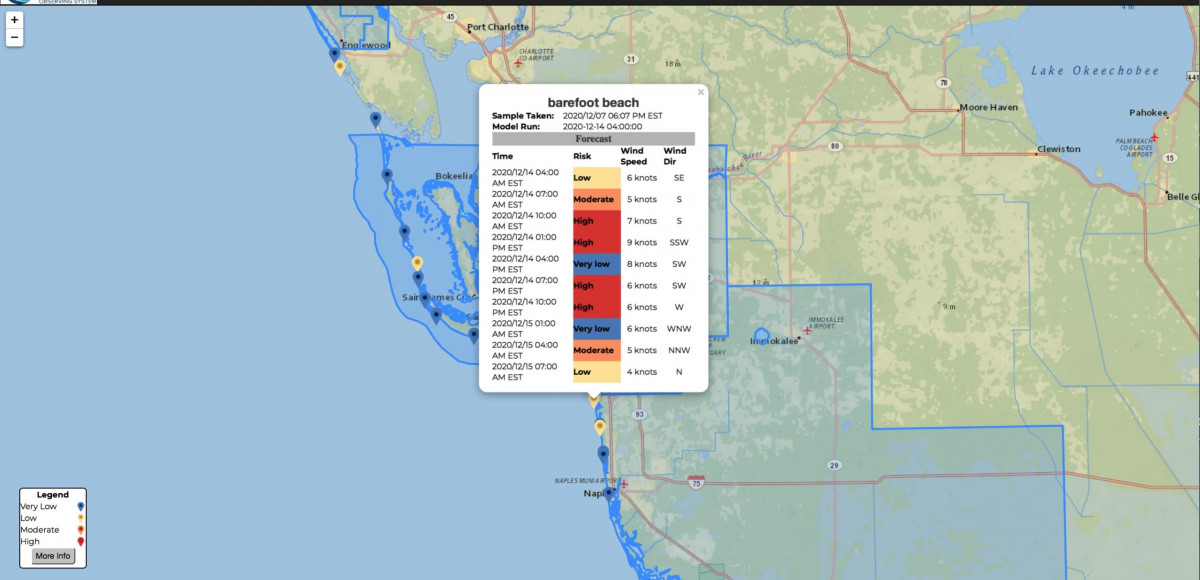
There’s some good news in the works for Florida and Texas residents, visitors and businesses susceptible to near-annual blooms of red tide in the Gulf of Mexico: The Red Tide Respiratory Forecast is being expanded to more Gulf Coast beaches thanks to new harmful algal bloom grants from the National Oceanic and Atmospheric Administration (NOAA) National Centers for Coastal Ocean Science (NCCOS) and the U.S. Integrated Ocean Observing System (IOOS).
The Red Tide Respiratory Forecast is a beach-level risk forecast activated during red tide conditions that tells beachgoers what red tide impacts are expected to be at individual beaches at different times of the day.
The Forecast was initially developed and tested in Pinellas County, Florida, in 2018, then expanded to Lee County. Today, it includes more than 20 Gulf Coast beaches and is hosted by GCOOS at habforecast.gcoos.org. (The number of beaches participating on a daily basis varies, depending on red tide conditions.)
Several groups are working together to expand the forecast to the Florida Panhandle and Texas beaches by recruiting more citizen science volunteers and providing them with the HABscope tool needed to process water samples for the forecast. The partners include scientists from NOAA-NCCOS, the Gulf of Mexico Coastal Ocean Observing System (GCOOS), Texas Sea Grant and their Red Tide Rangers and Florida’s Fish and Wildlife Research Institute (FWRI).
The Red Tide Respiratory Forecast was developed by NOAA-NCCOS in partnership with GCOOS, FWRI and Pinellas County Environmental Management through funding from the NASA Health and Air Quality Program.
Key to creating the Red Tide Respiratory Forecast is HABscope, a portable  microscope system (pictured above) that uses video and artificial intelligence (AI) to quickly analyze water samples for near real-time cell counts of Karenia brevis, the organism that causes red tide in the Gulf of Mexico.
microscope system (pictured above) that uses video and artificial intelligence (AI) to quickly analyze water samples for near real-time cell counts of Karenia brevis, the organism that causes red tide in the Gulf of Mexico.
To develop HABscope, researchers took a low cost, classroom-grade, portable microscope, outfitted it with a special adaptor — designed by the team’s engineer and printed on a 3D printer — then used that piece to mount an Apple iPOD touch to the eyepiece of the microscope. A portable power pack provides the power to light the microscope.
For the Forecast, a researcher or citizen science volunteer collects a water sample, places it under the microscope and uses the iPOD touch to take a video. Then, the video is uploaded GCOOS, which developed a special program that uses artificial intelligence to automatically identify Karenia brevis cells in the water sample as well as the number of cells present — the concentration of cells. The automated process reports its findings to researchers making red tide forecast models.
The result is more accurate information on a finer scale — the Red Tide Respiratory Forecast, habforecast.gcoos.org. The funding from NOAA and IOOS will help GCOOS develop a wider network of volunteers to contribute samples to the forecast, enabling it to expand to new communities.
“Our Red Tide Rangers have over 25 years of experience as citizen scientists, training for and monitoring red tides along the Texas coast. We look forward to contributing to and utilizing this innovative tool,” said Texas Sea Grant Agent Tony Reisinger, who oversees the Red Tide Ranger program. “Texas beach communities will benefit tremendously knowing the respiratory forecast during red tide blooms. The forecasts should ease some of the negative economic impact on tourism if visitors know where to go to avoid the red tide aerosol.”
NOAA NCCOS awarded the multi-year “Monitoring and Event Response for Harmful Algal Bloom (MERHAB)” research grant as part of a nationwide effort to improve monitoring of and response to harmful algal blooms (HABs) along U.S. coasts.
“When we initially discussed our vision for a beach-level forecast for respiratory impacts, we knew it would need to rely on low-cost tools and be as automated as possible to allow for trained volunteers to be able to work with scientists and forecasters,” Kirkpatrick said. “We accomplished our goal and are now ready to expand the forecast to new areas, thanks to these NOAA grants.”
In addition to getting more microscopes in more hands on more beaches, the $653,960 funding from NOAA NCCOS MERHAB and IOOS will also help the team test whether the system can be used to detect other species of toxic algae harmful to humans, Kirkpatrick said.
“Our Karenia brevis red tides do severe economic damage and cause human health problems. But this isn’t the only microorganism that causes problems in the Gulf. Pyrodinium bahamense is another toxic dinoflagellate that occurs in Florida’s estuaries.
“It produces saxitoxin — one of the deadliest natural toxins in the world — and it can be a public health risk in recreational fisheries. It can also cause paralytic shellfish poisoning (PSP), which causes closures of shellfish harvesting. If we can use HABscope to test for other toxins, we can increase the benefits to the public across even more sectors.”














